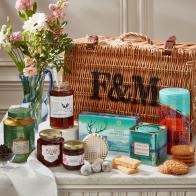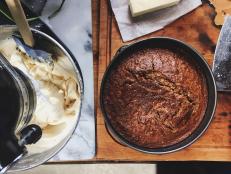Baking with Butter

The job of butter in baking (besides being delicious) is to give richness, tenderness and structure to cookies, cakes, pies and pastries. We alter the way butter works in a recipe by changing its temperature and choosing when to combine it with the other ingredients. For example, the same butter makes things fluffy when creamed with sugar, but creates airy pockets between layers of thin dough for perfectly flaky pie crust when ice-cold cubes are cut into dry flour. Here’s a rundown of some common butter-baking scenarios and a little bit about how each one works.
Laminated Dough
Folding dough in specific ways around very cold butter makes large, distinct layers of rich dough, like puff pastry and its offspring, croissant dough.
Biscuits and Pie Dough
Cutting small pieces of very cold butter into dry flour in turn coats small bits of flour with butter. This creates pockets of both dry flour and fat-coated flour. When you add water to the buttery floury meal, the dry flour parts form the crust’s flaky structure, while the buttery parts melt, leaving airy pockets and tenderness in their wake.
Creamed Butter
Creaming butter doesn’t actually involve cream. It’s just the name of a technique often used in making cakes, cupcakes and sometimes muffins that entails mixing butter together for a while with sugar until it becomes light in color and fluffy in texture. When you do this, sharp-edged sugar crystals cut little paths through the butter, trapping air (which expands even more during cooking) and creates fluffiness, tenderness and lightness in baked goods.
Unsalted Butter
When you use unsalted butter, you can control how salty your recipe will taste. Most recipes call for salt separately (and they assume you are using unsalted butter). If the only butter you have is salted, adjust the salt in the recipe to the best of your ability.
Room-Temperature Butter
Recipes call for room-temperature butter for a couple of reasons: First of all, it’s a lot easier to cream soft, spreadable butter than it is to wrestle chunks of fridge-cold butter around a bowl. But also, room-temperature butter can absorb more air than cold butter, leading to fluffier, more tender cakes and cookies.
Melted Butter
In some cakes, brownies and cookies, melted butter adds richness to dough and allows ingredients to blend together easily. Melted-butter desserts are often very simple for new cooks to make, and the desserts often require no special equipment. Cookies made with melted butter are thin, flat and often delightfully crispy. Cakes made with melted butter rely on other leaveners (often baking powder) to create loft.
Butter in Enriched Breads
Brioche, challah, cardamom buns and Danishes are made with yeast, but they are also tenderized and enriched with butter. These doughs combine the butteriness of laminated dough with the stretchier texture and more open crumb of a yeasted bread.
Related links:






























.jpg.rend.hgtvcom.231.174.suffix/1681323015319.jpeg)

